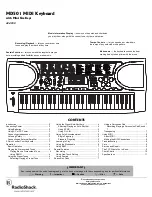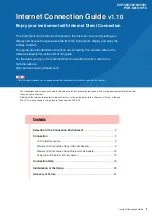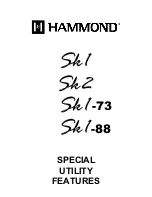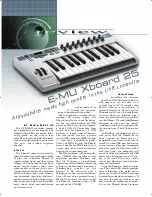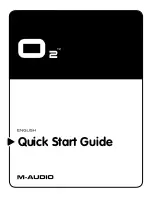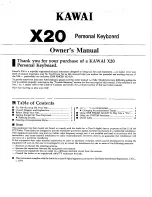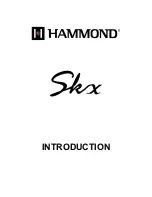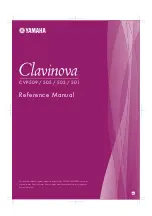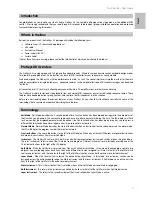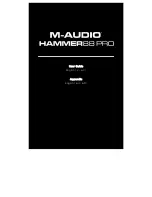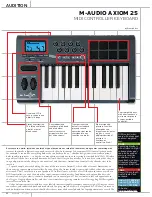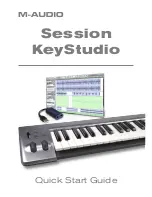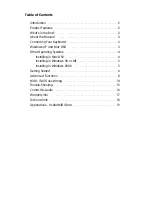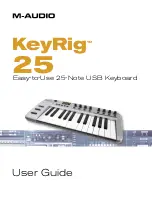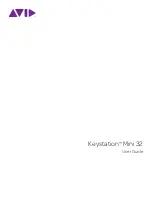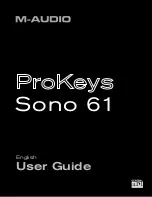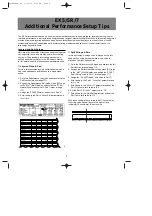
Axiom Line User Guide
18
English
3.3 How To Avoid Jumping Parameters
A common problem with MIDI controllers occurs when you move a physical controller and the receiving parameter on your external
MIDI gear or software jumps from its present setting to the position of the knob or fader that you are using. The result can be a
volume spike, a vibrato effect suddenly engaging or a pan position jumping from one side to another. The Axiom is well equipped to
avoid this situation.
3.3.1 Mute
The Mute button on your Axiom will turn off the MIDI data output from all controls. This allows you to re-position the knob or
faders that you are using to a setting that matches the current value of the parameter you are addressing.
When the controls are all muted, the LCD displays the MUTE symbol. The controls are un-muted by pressing the Mute button a
second time.
Note that Mute does not affect the assignable buttons, sustain pedal or the keyboard. This is because these controls send one-shot
MIDI controllers, so there is never a need to match them to the parameter they are controlling. So, Mute mode is disengaged when
you play the keyboard, or if you press an assignable button or the sustain pedal.
3.3.2 Null
The Null button engages Null mode which is used to temporarily deactivate the controls on your Axiom when you call up a new
memory location. Null mode blocks the controls from outputting MIDI data until they reach the same position at which you left
them the last time you used the memory location. When Null mode is active, there is never a worry that a control on your Axiom
will cause a parameter to jump.
Turn Null mode on and off at any time simply by pressing the Null button. When Null mode is active, the LED in the Null button
will be lit.
When you recall a preset, if Null mode is active moving a control on the Axiom engages a comparison between the current position
of the control and its position when you last used this preset. If the control is at a different position than where you last left it
before changing presets, the NULL symbol on the LCD display is shown and the numerical value displayed indicates how far away
you are from the original position. A negative number indicates that the current value is lower than where you had left it, and a
positive number indicates a higher value. As you move the control nearer to its original value, you see the numbers on the LCD
display tend towards 0. When 0 is reached, the NULL symbol turns off, and the control starts to output MIDI data again.
The current positions of every control are remembered each time you leave a memory to recall a new one, regardless of whether
Null mode is active or not.
The status of Null mode is stored on powering down your Axiom.
3.3.3 Snapshot
The Snapshot function sends out the current values of the sliders, Expression pedal, Modulation wheel, Pitch Bend wheel and rotary
encoders. This will adjust your software or external MIDI gear to the control positions on your Axiom.
Press the - and + buttons together to use the Snapshot function.
Snapshot can be used in conjunction with the Mute function (section 3.3.1) in order to perform a function not available on most
hardware synths. Use the Mute function to reposition the controls of your Axiom as you like, and then use the Snapshot function
to send all of the new positions at the same time.
3.4 The Rotary Encoders
As mentioned in section 2 it is possible to assign the rotary encoders to any MIDI controller message listed in Appendix C. When the
encoders are assigned to MIDI controllers, they work in the same way as the sliders on the Axiom 49 and 61—when the minimum or
maximum limit is reached, no more data is sent until you turn the dial the other way.
It is possible to program the encoders to increment or decrement the current value in the software, rather than sending an actual
value. This means that there is never a risk of causing your software parameters to jump if they do not match the position of the
control you’re moving.
Please note that not all software supports the use of rotary encoders. Also, those applications that do support them can differ in
the way that encoder support is implemented. The Axiom therefore supports several different types of increment/decrement MIDI
messages. You should check your software’s manual to see what message type is supported and how to engage endless dial support. To
help with this we have listed the names commonly used for each of the relative data methods. We have also provided the data values
used to represent data increment and data decrement. Where a range of values is specified for an increment or decrement, the range
is in the form “slow movement" to "fast movement”.
The Program change increment/decrement will send out program changes with each step.
Summary of Contents for AXIOM
Page 1: ...Axiom User Guide English...































